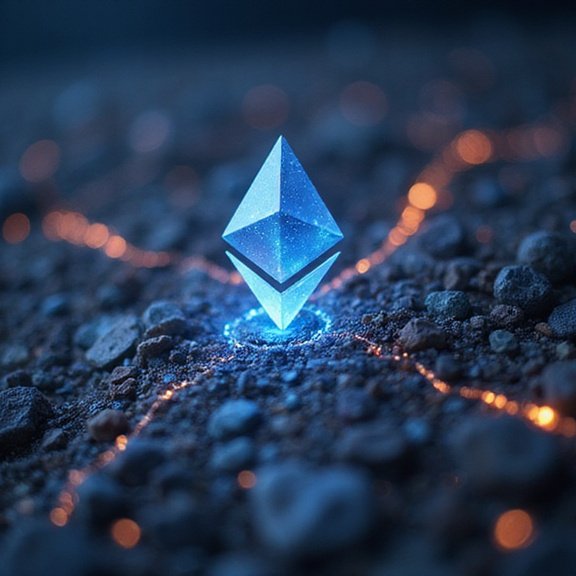Unlocking the Power of Ethereum: A Comprehensive Guide to the Ethereum Blockchain
Imagine a world where you can conduct transactions without the need for traditional banks, where contracts execute automatically without a third party, and where your digital assets are secure and immutable. This is not a distant future; this is the reality that Ethereum offers you today. As you delve into the realm of cryptocurrencies, you may find yourself overwhelmed by the rapid changes and complex technology that surrounds this digital revolution. You are not alone in this journey, and understanding Ethereum can empower you to make informed decisions about your finances and investments.

Reflecting on my own experience with Ethereum, I remember the excitement I felt when I first discovered its potential. Like many, I was initially drawn to the idea of making quick profits from the fluctuating ethereum price. However, as I learned more about Ethereum’s underlying technology—its blockchain and smart contracts—I realized there was something far more profound at play. Ethereum is not just a cryptocurrency; it is a transformative technology that is changing how we interact with each other and with the digital world. Your initial curiosity may lead to a deeper understanding of how this blockchain can enhance your life and opportunities.
The journey into Ethereum can feel daunting at times, especially when faced with the complex terminologies and technical jargon. But fear not! Whether you are looking to buy Ethereum, start mining it, or simply understand its applications, this guide will illuminate the path ahead. By the end, you will have a solid grasp of Ethereum’s functionalities, its ecosystem, and how you can harness its power to achieve your financial goals. Let’s embark on this exciting exploration together!
Understanding Ethereum and Its Blockchain
What is Ethereum?
Ethereum is a decentralized platform that enables developers to build and deploy smart contracts and applications. Unlike Bitcoin, which primarily functions as a digital currency, Ethereum provides a comprehensive blockchain ecosystem that supports a variety of applications. The Ethereum blockchain operates on a decentralized network of computers (nodes) that work together to validate transactions and maintain the integrity of the system.
The Technology Behind Ethereum Blockchain
At the core of Ethereum is its blockchain technology, which allows for the creation of decentralized applications (dApps) and smart contracts. Here’s how it works:
- Decentralization: Unlike traditional databases, where data is stored in a single location, Ethereum’s blockchain is distributed across all participating nodes, ensuring that no single entity has control over the entire network.
- Smart Contracts: These are self-executing contracts with the terms of the agreement directly written into code. They automatically enforce and execute actions based on predetermined conditions.
- Consensus Mechanism: Ethereum currently uses a Proof of Work (PoW) consensus mechanism, though it is transitioning to Proof of Stake (PoS) to improve scalability and reduce energy consumption.
Ethereum vs. Other Cryptocurrencies
When comparing Ethereum to other cryptocurrencies, such as Bitcoin, it’s essential to recognize their unique characteristics:
- Purpose: Bitcoin serves primarily as a digital currency, while Ethereum’s blockchain enables a wide array of applications beyond currency.
- Smart Contract Functionality: Ethereum introduces smart contracts, allowing for programmable and automated agreements, which Bitcoin lacks.
- Community and Development: Ethereum boasts a vibrant community of developers constantly innovating and building on the platform, leading to rapid technological advancement.
The Role of Smart Contracts in Ethereum
What Are Smart Contracts?
Smart contracts are the backbone of the Ethereum ecosystem. They are computer programs that execute automatically when certain conditions are met. Here’s why they are revolutionary:
- Automation: They eliminate the need for intermediaries, reducing costs and increasing efficiency.
- Transparency: The terms of the contract are visible and immutable, ensuring trust among parties.
- Security: Smart contracts are backed by cryptographic security, reducing the risk of fraud.
Examples of Smart Contracts in Action
Smart contracts have numerous applications, some of which include:
- Decentralized Finance (DeFi): DeFi platforms utilize smart contracts to facilitate lending, borrowing, and trading without traditional financial institutions.
- Supply Chain Management: Businesses can track products and verify transactions seamlessly, improving transparency and reducing fraud.
- Digital Identity Verification: Smart contracts can securely manage identities and ensure privacy while providing proof of authenticity.
How to Create Your Own Smart Contracts
Creating smart contracts on Ethereum requires some technical knowledge, but it is accessible to anyone willing to learn. Here’s a simple step-by-step guide:
- Learn Solidity: Solidity is the programming language used to write smart contracts on Ethereum.
- Set Up a Development Environment: Use tools like Remix IDE or Truffle to write and test your contracts.
- Deploy Your Contract: Once tested, deploy your contract on the Ethereum network using a wallet like MetaMask.
Investing in Ethereum: Opportunities and Risks
Understanding Ethereum Price Trends
The price of Ethereum has experienced significant fluctuations since its inception. To make informed investment decisions, you need to analyze various factors that influence ethereum price:
- Market Sentiment: News and developments in the crypto space can heavily influence investor sentiment, impacting prices.
- Technological Developments: Updates regarding the Ethereum blockchain, such as the transition to Ethereum 2.0, can affect long-term price predictions.
- Global Economic Factors: Economic trends, regulations, and institutional adoption all play a role in the price dynamics of Ethereum.
How to Buy Ethereum
If you’re ready to invest in Ethereum, here’s a simple guide:
- Choose a Cryptocurrency Exchange: Popular exchanges include Coinbase, Binance, and Kraken.
- Create an Account: Sign up for an account and complete any necessary identity verification.
- Deposit Funds: Fund your account using your preferred payment method, such as bank transfer or credit card.
- Buy Ethereum: Navigate to the trading section and place your order for Ethereum.
Risks Associated with Ethereum Investments
As with any investment, there are risks involved when buying Ethereum:
- Market Volatility: Prices can swing dramatically, leading to potential losses.
- Regulatory Risks: Changes in government regulations can impact the future of Ethereum.
- Technological Risks: Bugs or vulnerabilities in smart contracts can lead to financial loss.
Ethereum Mining: A Beginner’s Guide
What is Ethereum Mining?
Ethereum mining is the process by which new Ether (ETH) is created and transactions are verified on the Ethereum blockchain. Miners use computational power to solve complex mathematical problems, validating transactions and maintaining the network’s security.
The Mining Process Explained
Here’s a basic overview of how Ethereum mining works:
- Transaction Submission: When users initiate transactions, they are grouped into blocks.
- Problem Solving: Miners compete to solve a cryptographic puzzle associated with the block.
- Block Verification: The first miner to solve the puzzle adds the block to the blockchain and is rewarded with Ether.
How to Start Mining Ethereum
If you are interested in mining Ethereum, consider the following steps:
- Choose Your Mining Hardware: Select a powerful graphics processing unit (GPU) or consider joining a mining pool.
- Install Mining Software: Use software like Ethminer or Claymore to connect to the Ethereum network.
- Join a Mining Pool: Collaborate with other miners to increase your chances of earning rewards.
Ethereum Mining vs. Proof of Stake
As Ethereum transitions to Proof of Stake (PoS) through Ethereum 2.0, traditional mining is set to change dramatically. Here’s a comparison:
- Energy Consumption: PoS reduces energy consumption significantly compared to mining.
- Rewards Distribution: In PoS, validators are chosen based on the amount of Ether they hold and are willing to “stake,” rather than their computational power.
- Security and Scalability: Ethereum 2.0 aims to enhance security and scalability, making the network more robust.
Keeping Up with Ethereum News and Developments
Where to Find Reliable Ethereum News
Staying informed about Ethereum developments is crucial for investors and enthusiasts. Here are some reliable sources for ethereum news:
- Official Ethereum Blog: The Ethereum Foundation shares updates and insights directly from the source.
- Cryptocurrency News Websites: Websites like CoinDesk and CoinTelegraph provide regular updates and analysis.
- Social Media and Forums: Engage with the Ethereum community on platforms like Twitter, Reddit, and Discord for real-time discussions.
Upcoming Ethereum Upgrades and Their Implications
Ethereum is continuously evolving. Be on the lookout for major upgrades such as Ethereum 2.0, which aims to improve scalability and transition to a PoS model. Each upgrade can significantly impact the network and its price, so staying updated is essential.
The Future of Ethereum: Trends to Watch
As you navigate through the Ethereum landscape, keep these trends in mind:
- Integration with Traditional Finance: Watch for developments that bridge the gap between DeFi and traditional finance.
- Increased Adoption of NFTs: The rise of Non-Fungible Tokens (NFTs) represents a growing sector within the Ethereum ecosystem.
- Environmental Considerations: The shift to PoS reflects a broader trend towards sustainable practices in cryptocurrency.

Frequently Asked Questions (FAQ)
What is Ethereum?
Ethereum is a decentralized platform that allows developers to build and deploy smart contracts and dApps (decentralized applications). Unlike Bitcoin, which primarily serves as digital currency, Ethereum provides a versatile blockchain environment that powers a variety of applications, enabling automatic transactions and processes.
How do I buy Ethereum?
To buy Ethereum, you need to choose a cryptocurrency exchange such as Coinbase or Binance. Create an account, complete the necessary identity verification, and fund your account using a bank transfer or credit card. Navigate to the trading section and place an order to buy Ethereum. Always ensure you keep your Ethereum in a secure wallet.
What are smart contracts?
Smart contracts are self-executing contracts with the terms of the agreement coded into them. They automatically execute when conditions are met, reducing the need for intermediaries and enhancing trust through transparency and security. Smart contracts are a critical component of the Ethereum blockchain.
What is Ethereum mining?
Ethereum mining is the process by which new ETH is created and transactions are validated on the Ethereum blockchain. Miners solve complex mathematical problems to add blocks to the blockchain and are rewarded with Ether. However, Ethereum is transitioning to a Proof of Stake (PoS) consensus mechanism, which will phase out traditional mining.
What is Ethereum 2.0?
Ethereum 2.0 is an upgrade to the Ethereum network that aims to improve scalability and security. It transitions the network from a Proof of Work (PoW) to a Proof of Stake (PoS) consensus mechanism, allowing for faster transaction processing and reduced energy consumption.
How does the Ethereum price fluctuate?
The Ethereum price fluctuates based on multiple factors, including market sentiment, technological developments, regulatory news, and overall economic conditions. Investors often look for patterns and trends to predict future movements in price.
What are some use cases of Ethereum?
Ethereum has a wide range of use cases, including decentralized finance (DeFi), supply chain management, digital identity verification, and the creation of Non-Fungible Tokens (NFTs). Its versatility makes it a preferred choice for developers building innovative blockchain applications.
What is the role of the Ethereum community?
The Ethereum community plays a vital role in the platform’s development and innovation. Developers, miners, users, and enthusiasts collaborate to improve the network, propose enhancements, and share knowledge. Community-driven projects often lead to significant advancements in the Ethereum ecosystem.
Conclusion: Embrace the Future with Ethereum
As you conclude this exploration into the world of Ethereum, it’s clear that this innovative technology is reshaping the landscape of finance, contracts, and digital interaction. From understanding what Ethereum is and how its blockchain operates to recognizing the potential of smart contracts and the importance of staying updated with the latest news, you have gained valuable insights. The volatility of the ethereum price may seem daunting, but with understanding comes the ability to navigate these uncertainties.
Whether you are considering investing in Ethereum, exploring mining, or developing your own dApps and smart contracts, the opportunities are vast. By remaining engaged with the community and staying informed about upgrades and trends, you position yourself to take full advantage of what Ethereum has to offer. So, take that first step—buy Ethereum, dive into its technology, or participate in discussions within the community. Your journey is just beginning.
In this fast-evolving world, the key to success lies in your ability to adapt and learn. Embrace the possibilities that Ethereum presents, and become an active participant in the digital revolution. The future is bright, and you have the power to shape it. Are you ready to take the leap?
Key Takeaways
- Ethereum is more than a cryptocurrency: It is a decentralized platform that allows for the creation of smart contracts and dApps.
- Smart contracts automate agreements: They provide transparency and security, enhancing trust in transactions.
- Investment in Ethereum involves understanding risks: Be aware of market volatility and regulatory changes.
- Ethereum mining will transition to Proof of Stake: This shift will reduce energy consumption and change how rewards are distributed.
- Staying informed is crucial: Regularly check reliable news sources and engage with the Ethereum community for insights.













